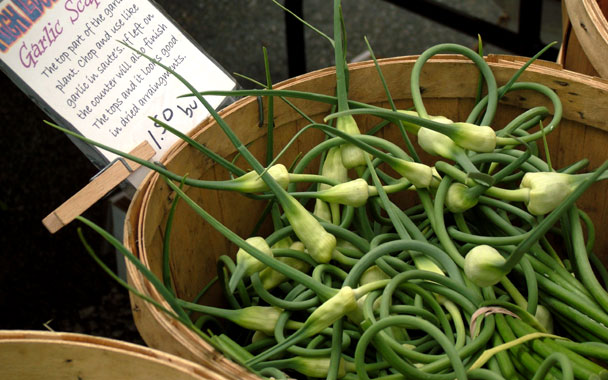I hang around with a lot of smart people in my day job, so I’m used to feeling like I’m not the sharpest tool in the shed, but nothing makes me feel dumb faster than a conversation with most farmers I know. Jim Grillio at Northshire Farms, my go-to guy for sorrel, was the latest culprit. I noticed some flowering tops mixed in with his sorrel leaves a week ago and asked, “just another week or two for this, right?” “No, no,” came the reply, in a heavy New York accent. “I’ll have that into late summer.” I was stunned. “But Jim, it’s bolting, right? Here, see, it’s stemmy and going to flower. Won’t you stop harvesting after it bolts?” “No, that’d be stupid. What I do is, when the plants start to flower, I cut about a quarter of them off at the ground each week and sell those leaves. The next week I cut back the next quarter of the field. After a month I’m back to new growth, and the plants are thriving.” So that part of my article a couple weeks ago where I said that sorrel is a spring crop? Scratch that—and remind me not to extrapolate my gardening experience to the big leagues.
A big part of being a smart farmer, as far as I can tell, is figuring out how to make enough money to stay afloat. One good trick is to sell at least some crops that don’t take much to grow—weeds, say, or, at this time of year, garlic scapes.
Garlic comes in two types: the pungent hardnecks, including the various porcelain, rocambole, and purple striped varieties, and the softnecked varieties more popular in Asia. (Elephant garlic is actually a kind of leek. No elephants are involved, either.) I prefer the hardnecks because they keep better and, to my taste, have more interesting flavors to go along with the fire. But they’re a little fussier to grow: Left to their own devices, the plants will form a long, graceful stalk, known as a scape, with a seed head at the end; growing that stalk takes energy away from the main bulb (the crop, in other words). So farmers snip off the stalk before the seed head blooms into a flower—and then, lucky us, they bring those scapes to the farmers’ market, where they sit in piles like long green pigs’ tails curled gracefully around on themselves.
Garlic scapes are available for about ten minutes a few weeks before the season’s first heads of garlic, and I use them in place of minced garlic bulbs in anything and everything. Their flavor is not as strong as that of garlic cloves, and they have a nice vegetal note that seems in keeping with the chlorophyll party happening every evening at dinner. In the last two nights I’ve made a garlic scape aioli (I grated the scape on a Microplane to make green mayonnaise—that was cool) and used them in the first pesto of the year. Tomorrow I’ll sauté some thinly sliced scapes with fava beans. I’m also planning to roast some whole in the oven to serve beside a lamb roast. My name is Robert, and I have a problem with garlic scapes.
You can read more about garlic varieties, farming, and life in the best book ever written on garlic.




 Pinterest
Pinterest


